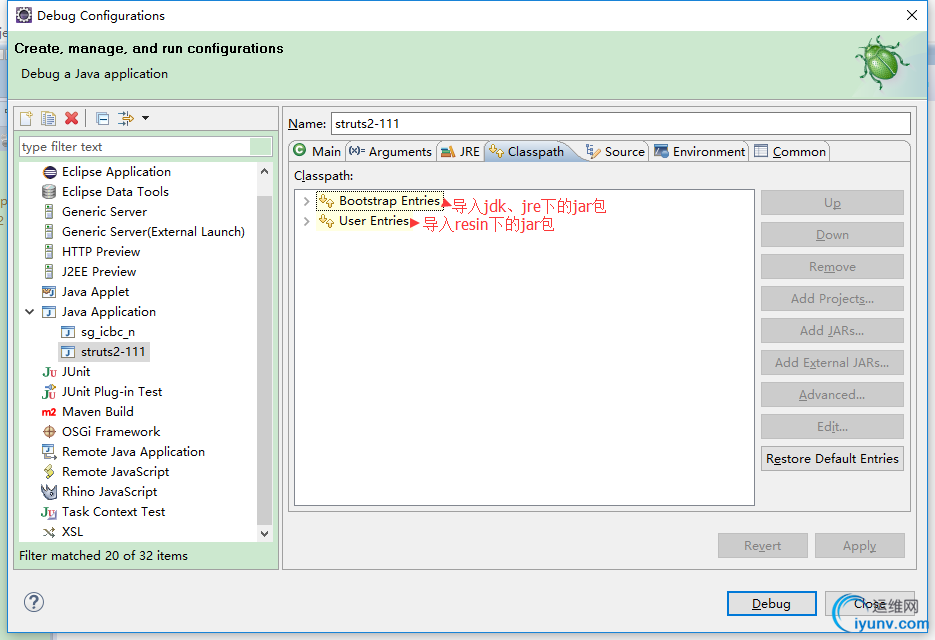|
|
Resin 与 Eclipse for JavaEE 的整合方法:
1.新建一个项目,将web application配置到resin.conf中
附上resin_struts2-111.conf文件:(为方便区分我将这个conf文件命名为resin_项目名.conf)
<!--
- Resin 3.1 配置文件.
-->
<resin xmlns="http://caucho.com/ns/resin"
xmlns:resin="http://caucho.com/ns/resin/core">
<!-- 加载resin/lib下的所有.jar文件 -->
<class-loader>
<tree-loader path="${resin.home}/ext-lib"/>
<tree-loader path="${resin.root}/ext-lib"/>
<tree-loader path="${resin.home}/lib"/>
<tree-loader path="${resin.root}/lib"/>
</class-loader>
<!--
管理配置
-->
<management path="${resin.root}/admin">
<user name="admin" password="password" disable="true"/>
<resin:if test="${resin.professional}">
<deploy-service/>
<jmx-service/>
<log-service/>
<xa-log-service/>
</resin:if>
</management>
<!--
-JDK日志接口的配置
-
-->
<log name="" level="info" path="stdout:"
timestamp="[%H:%M:%S.%s] {%{thread}} "/>
<!--
日志信息的级别:'info' 生产环境 'fine' 开发环境 'finer' 调试环境
-->
<logger name="com.caucho" level="info"/>
<logger name="com.caucho.java" level="config"/>
<logger name="com.caucho.loader" level="config"/>
<!--
- 环境上下文的检测时间,对于生产站点, 这个要设置长一点,例如600秒,10分钟
-->
<dependency-check-interval>2s</dependency-check-interval>
<!--
- 发送邮件通知的SMTP服务器
-->
<system-property mail.smtp.host="127.0.0.1"/>
<system-property mail.smtp.port="25"/>
<!--
- Sets the default character encoding to utf-8
-
- <character-encoding>utf-8</character-encoding>
-->
<!--
-你可以把编译器改成 "javac", "eclipse" 或者 "internal".
-->
<javac compiler="internal" args="-source 1.5"/>
<!-- Security providers.
- <security-provider>
- com.sun.net.ssl.internal.ssl.Provider
- </security-provider>
-->
<!-- 去掉注释,如果你使用resin提供的xml应用
-
- <system-property javax.xml.parsers.DocumentBuilderFactory
- ="com.caucho.xml.parsers.XmlDocumentBuilderFactory"/>
- <system-property javax.xml.parsers.SAXParserFactory
- ="com.caucho.xml.parsers.XmlSAXParserFactory"/>
-->
<cluster id="app-tier">
<!-- 设置集群上下文的根, 相对于server.root -->
<root-directory>.</root-directory>
<server-default>
<!-- HTTP服务的端口 -->
<http address="*" port="8001"/>
<!--
- SSL端口配置:
-
- <http address="*" port="8443">
- <openssl>
- <certificate-file>keys/gryffindor.crt</certificate-file>
- <certificate-key-file>keys/gryffindor.key</certificate-key-file>
- <password>test123</password>
- </openssl>
- </http>
-->
<!--
- JVM参数设置
-->
<jvm-arg>-Xmx256m</jvm-arg>
<jvm-arg>-Xss1m</jvm-arg>
<jvm-arg>-Xdebug</jvm-arg>
<jvm-arg>-Dcom.sun.management.jmxremote</jvm-arg>
<!--
- Uncomment to enable admin heap dumps
去掉这个如果你想管理内存堆的倾倒
- <jvm-arg>-agentlib:resin</jvm-arg>
-->
<!--
- arguments for the watchdog process
-->
<watchdog-jvm-arg>-Dcom.sun.management.jmxremote</watchdog-jvm-arg>
<watchdog-port>6600</watchdog-port>
<!--
- 强制resin强制重起时的最小空闲内存
-->
<memory-free-min>1M</memory-free-min>
<!-- 最大线程数量 -->
<thread-max>256</thread-max>
<!-- 套接字等待时间 -->
<socket-timeout>65s</socket-timeout>
<!-- 配置 keepalive-->
<keepalive-max>128</keepalive-max>
<keepalive-timeout>15s</keepalive-timeout>
<!--
-如果使用的是UNIX,这里是启动的帐号和用户组.
-
- <user-name>resin</user-name>
- <group-name>resin</group-name>
-->
</server-default>
<!--定义群集服务器-->
<server id="" address="127.0.0.1" port="6800"/>
<!--
-配置独立服务器或者群集的持久化存储,专业版的功能
-->
<resin:if test="${resin.professional}">
<persistent-store type="cluster">
<init path="session"/>
</persistent-store>
</resin:if>
<!--
-为了安全, 你可以为SSL会话(SSL sessions)定义一个不同的cookie.
- <ssl-session-cookie>SSL_JSESSIONID</ssl-session-cookie>
-->
<!--
- 缓存启用 (专业版的功能)
-->
<resin:if test="${resin.professional}">
<cache path="cache" memory-size="64M">
<!-- Vary header rewriting for IE -->
<rewrite-vary-as-private/>
</cache>
</resin:if>
<!--
- 启用周期性的服务器状态检查和死锁检查,所有的服务器可以添加 <url> 来检查。
-->
<resin:if test="${resin.professional}">
<ping>
<!-- <url>http://localhost:8080/test-ping.jsp</url> -->
</ping>
</resin:if>
<!--
- Defaults applied to each web-app.
-->
<web-app-default>
<prologue>
<!--
-扩展库的公共jar文件,扩展是安全的即使没有类装载器知道的jars,装载的类将为每个应用分别装载,也就是这些类都是不同的
-->
<class-loader>
<tree-loader path="${resin.root}/ext-webapp-lib"/>
</class-loader>
<!--
- 启用EL表达式
-->
<allow-servlet-el/>
</prologue>
<!--
- 设置缓存页、静态也的延时值
-->
<cache-mapping url-pattern="/" expires="5s"/>
<cache-mapping url-pattern="*.gif" expires="60s"/>
<cache-mapping url-pattern="*.jpg" expires="60s"/>
<cache-mapping url-pattern="*.png" expires="60s"/>
<!--
- 安全原因, 默认禁用了会话的URLs
-->
<session-config>
<enable-url-rewriting>false</enable-url-rewriting>
</session-config>
<!--
- 安全原因, 在cookies中设置HttpOnly标志
- <cookie-http-only/>
-->
<!--
-一些JSP包有不正确的 .tld文件。可以把validate-taglib-schema设置成false,可能继续正常工作
-->
<jsp>
<validate-taglib-schema>true</validate-taglib-schema>
<fast-jstl>true</fast-jstl>
</jsp>
</web-app-default>
<!-- includes the app-default for default web-app behavior -->
<resin:import path="${resin.home}/conf/app-default.xml"/>
<!--
- 简单的数据池配置
-
- The JDBC name is java:comp/env/jdbc/test
<database>
<jndi-name>jdbc/mysql</jndi-name>
<driver type="org.gjt.mm.mysql.Driver">
<url>jdbc:mysql://localhost:3306/test</url>
<user></user>
<password></password>
</driver>
<prepared-statement-cache-size>8</prepared-statement-cache-size>
<max-connections>20</max-connections>
<max-idle-time>30s</max-idle-time>
</database>
-->
<!--
- 定义所有虚拟主机的默认配置
-->
<host-default>
<!--
-如果和别的web服务器整合,这个可以被去掉,因为web服务器也可以记录这些信息。
-->
<access-log path="logs/access.log"
format='%h %l %u %t "%r" %s %b "%{Referer}i" "%{User-Agent}i"'
rollover-period="1W"/>
<!-- war 文件的布置目录 -->
<web-app-deploy path="webapps"/>
<!-- ear文件的布置目录 -->
<ear-deploy path="deploy">
<ear-default>
<ejb-server>
<config-directory>WEB-INF</config-directory>
</ejb-server>
</ear-default>
</ear-deploy>
<!-- rar文件的布置目录 -->
<resource-deploy path="deploy"/>
</host-default>
<!-- 虚拟主机的布置目录 -->
<host-deploy path="hosts">
<host-default>
<resin:import path="host.xml" optional="true"/>
</host-default>
</host-deploy>
<!-- 默认的虚拟主机配置 -->
<host id="" root-directory=".">
<!--
- 配置默认的应用 webapp's ROOT
-->
<!--
注意:若使用myeclipse/eclipse创建项目,会有一个项目名(projectName),而此处的root-directory并非项目路径,而是一个特殊的目录,该目录的子目录以及文件必须符合Servlet规范,通常就是eclipse默认创建的WebContent,这个名字可以随便改。btw,这个规范的层级结构主要有三个元素:
/WEB-INF/web.xml
/WEB-INF/classes/
/WEB-INF/lib/
必须包含有上面三个东西。配置文件(*.properties, *.xml等等)需要放在classes下
-->
<web-app id="/struts2" root-directory="D:\RuahoDemo\projectWorkpace\struts2-111\WebContent"/>
<web-app id="/resin-admin" root-directory="${resin.home}/php/admin">
<!--
- 管理应用程序 /resin-admin
-->
<prologue>
<resin:set var="resin_admin_external" value="false"/>
<resin:set var="resin_admin_insecure" value="true"/>
</prologue>
</web-app>
</host>
</cluster>
<!--
- Configuration for the web-tier/load-balancer
-->
<resin:if test="${resin.professional}">
<cluster id="web-tier">
<server-default>
<!-- The http port -->
<http address="*" port="9080"/>
</server-default>
<server id="web-a" address="127.0.0.1" port="6700"/>
<cache path="cache" memory-size="64M"/>
<host id="">
<web-app id="/">
<rewrite-dispatch>
<load-balance regexp="" cluster="app-tier"/>
</rewrite-dispatch>
</web-app>
</host>
</cluster>
</resin:if>
</resin>
2.Run – Run Configurations(在本地调试的话,选择Debug Configurations)
弹出的会话中,双击“Java Application”创建一个Configuration,在右边的Name中随意填写一个名字,标签页Main中,Project选择待运行web application,Main class填写resin的主类,查找该类有两种方法:
- 该类可以在${RESIN_HOME}/lib/resin.jar中的META-INF/MANIFEST.MF文件中找到,即Main-Class的值;
- 将${RESIN_HOME}/lib添加到项目的classpath后,即在Main标签页点击“搜索”,在弹出的对话框中搜索“resin”,如果是3.0.x,选择com.caucho.server.resin.Resin,如果是3.1.x,选择com.caucho.boot.ResinBoot,具体的选择,还是要参考META-INF/MANIFEST.MF文件的Main-Class值,如图:

标签页 Arguments中:

VM Arguments中:
-Dresin.home=D:\Ruaho\resin\resin-3.1.12 (实际路径)
-Djava.util.logging.manager=com.caucho.log.LogManagerImpl
-Xmx1024m
ClassPath标签页中:导入jar包

完成以上各步之后,点击Run即可启动resin。 |
|
|